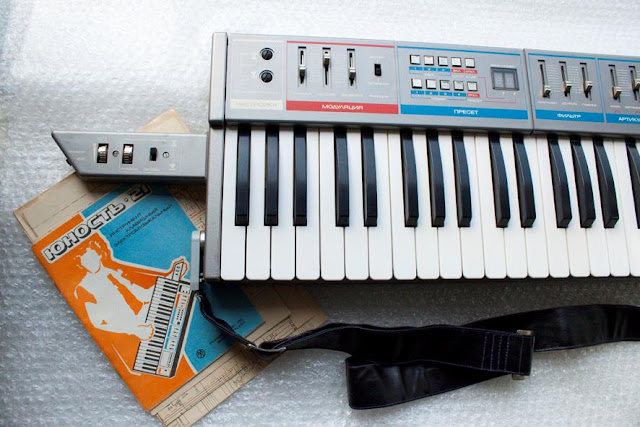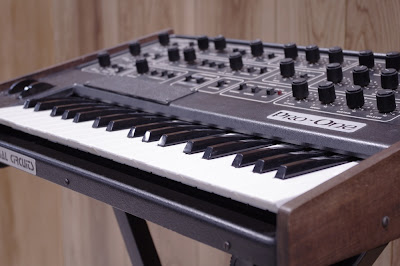
via
this auction
"Junost-21 is a portable polyphonic keyboard EMI. A player can hang it on a shoulder. Timbre of sound can be changed in accordance with players desire by the use of controls or choosing one or 12 programed timbres with digital indication of chosen one. You can get a variety of interesting warm analog sounds when cut off the presets and shape the sound by controls ( filter, envelope, modulation etc.). The instrument changes sounding during playing composition using such effects as chorus, unison, transposition with continuous and coarse control, frequency and timbre vibrato with continuous frequency, depth and delay time control, fixed and dynamic change of timbre, attack and fading of sound.

Sliders on the main synth body: LFO depth, speed, delay, routing to filter or VCO. Presets: three banks of four. Two-digit LED. VCF and VCA each with AD envelope.
Controls on grip: volume, tuning and chorus.
CONNECTIONS: Line Out on a standart 1/4 mono Jack adapter; 5Din power supply socket.

Specifications:
Formation of envelope in volume with attack and fading duration control.
Formation of envelope in timbre with attack duration control, fading, level and depth of timbre control.
Frequency and timbre vibrato in depth, frequency, pre- delay control.
Transposing on an octave (continuous and coarse)

Tuning of the musical range.
There is a filter with continuous range, depth and sharpness control.
Possibility to control cutoff frequency of filter by the keyboard.
Fixed choice of chorus and unison sounding.
Volume control

Number of octaves in a keyboard (from "F" to "E") 4
In audible range 6
Number of programmed timbres 12
Power consumption max 11V*A
Dimensions
- without power unit and case max 85x260x860 mm
- in case max 130x330x945 mm
Weight
- without power unit and case max 6,5 kg
- in case max 13 kg
Amplitude output max 2,4 V
Signal/(Backgound+noise) in a pause max 55dB
Relative frequency instability of leading generator over 4 hours of working max 0,3 %
THE SET INCLUDES
All original factory set - synthesizer, power supply, manual with schematics, strap and hard case."
SN 16100
 Update:
Update:  * double click on the empty area of Sound Net -> Create a new module;
* double click on the empty area of Sound Net -> Create a new module;


























































